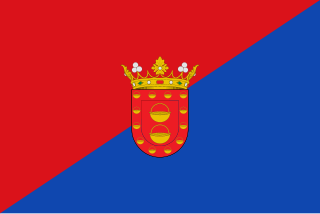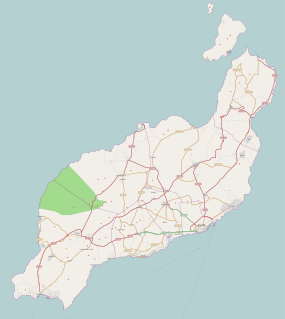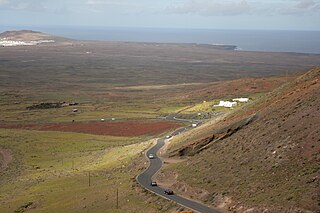
The Canary Islands, also known informally as the Canaries, is a Spanish archipelago in the Atlantic Ocean, in a region known as Macaronesia. At their closest point to the African mainland, they are 100 kilometres west of Morocco. They are the southernmost of the autonomous communities of Spain, and are located in the African Tectonic Plate. The archipelago is economically and politically European, and is part of the European Union.

The Province of Las Palmas is a province of Spain, consisting of the eastern part of the autonomous community of the Canary Islands.

Gran Canaria, also Grand Canary Island, is the second most populous of the Canary Islands, an archipelago off the Atlantic coast of Northwest Africa which is part of Spain. As of 2019 the island had a population of 851,231 that constitutes approximately 40% of the population of the archipelago.

Lanzarote is a Spanish island, the northernmost and easternmost of the autonomous Canary Islands in the Atlantic Ocean. It is located approximately 125 kilometres off the north coast of Africa and 1,000 kilometres from the Iberian Peninsula. Covering 845.94 square kilometres, Lanzarote is the fourth-largest of the islands in the archipelago. With 152,289 inhabitants at the start of 2019, it is the third most populous Canary Island, after Tenerife and Gran Canaria. Located in the centre-west of the island is Timanfaya National Park, one of its main attractions. The island was declared a biosphere reserve by UNESCO in 1993. The island's capital is Arrecife.

Puerto del Carmen is the main tourist town on the island of Lanzarote, Canary Islands, Spain. It is part of the municipality of Tías. Most of Lanzarote's over 1 million visitors per year choose this town as their destination. As a result, almost all of the town's economy revolves around tourism.

San Bartolomé is a town and municipality in the Canary Islands (Spain) situated in the centre of the island of Lanzarote. The municipality of San Bartolomé stretches to the southeastern coast of the island.

Tinajo is a municipality in the western part of the island of Lanzarote in the Province of Las Palmas in the Canary Islands, Spain. The population is 6119 (2018), and the area is 135.28 square kilometres (52.23 sq mi). The municipality is located on the island's northwestern coast and is northwest of the island's capital, Arrecife. The main town in the municipality is Tinajo.

Timanfaya National Park is a Spanish national park in the southwestern part of the island of Lanzarote, in the Canary Islands. It covers parts of the municipalities Tinajo and Yaiza. The area is 51.07 square kilometres (19.72 sq mi), and the parkland is entirely made up of volcanic soil. The statue El Diablo by César Manrique is its symbol. It is the only Natural Park in Spain which is entirely geological, also Timanfaya National Park represents a sign of recent and historical volcanism in the Macaronesian Region. The last volcanic eruptions occurred during the 18th century as well as on the 19th century.
Hacha Grande is a mountain on the Canary Island of Lanzarote, with an elevation of 562 m (1844 ft) above sea level. Its name is Spanish meaning Large Axe.

The Roman Catholic Diocese of San Cristóbal de La Laguna, also called Diocese of Tenerife or Diocese Nivariense, is a diocese located in the city of San Cristóbal de La Laguna in the Canary Islands in the Ecclesiastical province of Sevilla in Spain. The diocese includes the islands of Tenerife, La Palma, La Gomera and El Hierro, in the province of Santa Cruz de Tenerife. The bishop of this diocese is Bernardo Álvarez Afonso.

Playa Blanca is the southernmost town of the Spanish island of Lanzarote. It is the newest resort on the island, and is part of the municipality of Yaiza.
Tourism is an essential part of the economy of the Canary Islands, a Spanish archipelago located in the Atlantic Ocean, 100 kilometres west of Morocco. Seven main islands and six islets make up the Canary Islands. They had more than 9 million foreign incoming tourists in 2007. Tourists seeking sunshine and beaches first began to visit the Canaries in large numbers in the 1960s. The Canary Islands are a leading European tourist destination with very attractive natural and cultural resources.
The Divisiones Regionales de Fútbol in the Canary Islands are ultimately overseen by the Federación Canaria de Fútbol which operates Group 12 of the Tercera División, the fourth tier of the Spanish football league system which is divided among each of the country's autonomous regions. However, unlike most of the regions, the leagues in the fifth tier and below are organised by two separate federations, corresponding to the provinces of Las Palmas and Tenerife. The other regions with this arrangement are the Basque Country and the Balearic Islands which each have three provincial forks to its amateur setup.

Betancuria is a small town and a municipality in the western part of the island of Fuerteventura in the Province of Las Palmas, Canary Islands, Spain. The population is 811 (2013), and the area is 103.64 km2 (40 sq mi). It is situated in a mountainous region, 4 km (2 mi) west of Antigua and 21 km (13 mi) southwest of the island capital Puerto del Rosario. By population it is the smallest municipality in Fuerteventura as well as all of the Canary Islands.

Charco del Palo is a naturist holiday village on the north-eastern coast of Lanzarote, in the Canary Islands. The village was established around 1970 by the German entrepreneur Gregor Kaiser. In due course, it has developed into a popular naturist resort. It was the first official naturist resort established in the Canaries: nudity is permitted everywhere in the village, and practised universally. Its isolated location, at the end of a dedicated three kilometer long access road, helps to achieve privacy, while the village remains open to all. Visitors are mainly German, British, and Dutch. The village's population increased from 82 in the year 2000 to 229 in 2011, it has subsequently declined to 156 in 2013.

El Rubicón is a flat gravel plain located at the southernmost end of the island of Lanzarote in the Yaiza municipality. The plain is to the south of the 'Los Ajaches' range of hills and the lava fields of Timanfaya national park.
The following is a timeline of the history of the city of Las Palmas, Canary Islands, Spain.
As in the rest of Spain, the majority religion in the Canary Islands is the Catholic Church. The Catholic religion has been the majority since the Conquest of the Canary Islands in the fifteenth century. This religion would largely replace the Canarian aboriginal religion through the prohibition of the latter and syncretism. According to a survey conducted in 2019, Canary Islands is the fifth autonomous community in Spain with the highest percentage of people who declare themselves to be Catholics after the Region of Murcia, Extremadura, Galicia, Aragon, and Castile and León. 76.7% of the population is Catholic.


















